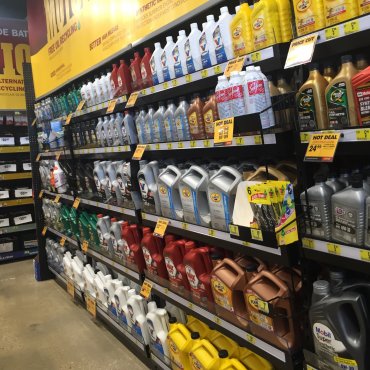
Shell was the largest North American lubricants supplier in 2018, beating out ExxonMobil and Chevron, according to consultancy Kline & Co., which also predicts North American finished lube sales will stay flat in the near future.
ExxonMobil and Chevron were second and third, respectively, with Valvoline and BP rounding out the top five in sales. Phillips 66, HollyFrontier, Citgo, Mexlub and Roshfrans made up the rest of the top 10, said the Parsippany, New Jersey-based firm.
Seven of the top 10 companies made a majority of their sales in the United States, one of the two largest finished lube markets, said Kline, while HollyFrontier saw practically all of its North American business through sales in Canada, and Mexlub and Roshfrans made all their sales in Mexico.
The top 10 suppliers accounted for around 45 percent of total demand in North America, but Kline did not list market shares for individual companies. Shell was the top supplier in the U.S., followed by ExxonMobil and Chevron, while ExxonMobil claimed the top spot in Mexico with Shell in second and Mexlub third.
HollyFrontier had the biggest share in Canada, owing to its ownership of Petro-Canada, said Pooja Sharma, project manager in Klines energy practice. The company has a well-integrated business model in Canada where it produces base stocks as well as distributes a wide variety of finished lubricants, including synthetic and mineral products, she explained during an Oct. 16 webinar. ExxonMobil and Shell were the second- and third-largest suppliers in Canada.
Finished lubricant demand in North America has been flat for several years, totaling 2.9 billion gallons (9.9 million metric tons) in 2013 and remaining at that number in 2018. Kline projected that demand will still be 2.9 billion gallons in 2023.
Industrial oils and fluids are the biggest market segment for North American lubricant demand, accounting for almost half of the market. The category includes process oils, industrial engine oils, marine engine oils, general industrial oils, metalworking fluids and greases.
North Americas larger industrial oils demand can be attributed to its huge appetite for process oils, said Sharma. The demand for process oils in the region is driven by cosmetics and personal care-based applications, as well as by the rubber and tire manufacturing industries.
Industrial oils arent quite as popular in Mexico as in the U.S. and Canada, and its demand is split almost evenly between industrial, consumer automotive and commercial automotive oils. Sharma explained that the U.S. and Canada have larger industrial sectors, and thus higher demand for industrial lubes.
Kline forecasts that U.S. industrial lubricant demand will remain flat with a 0 percent compound annual growth rate through 2023. Process oils made up almost half of all demand in the segment, followed by general industrial oils, industrial engine oils, metalworking fluids and grease. The segment increased marginally recently. The overall demand for industrial lubricants has seen growth in the last five years, driven by the growth in the U.S. manufacturing sector, which has driven the growth in process oils and metalworking fluids in particular, said Sharma. In fact, demand for those two categories of products is expected to increase, she continued.
Kline said demand for commercial automotive lubes in the U.S. will decrease at a cumulative annual rate of 0.9 percent through 2023 to just over 500 million gallons. Heavy-duty motor oil accounted for close to three-fourths of commercial automotive lube demand, followed by hydraulic and transmission fluids, gear oil and grease. The segment saw slight growth the past five years thanks to growth in U.S. manufacturing and consumer spending, said Sharma.
The consultancy expects U.S. demand for consumer automotive lubricants to decrease at a cumulative annual rate of 1.7 percent, to less than 600 million gallons in 2023. Passenger car motor oil and motorcycle motor oil make up the large majority of that number, followed by automatic transmission fluid. An increasing use of better quality oils, increasing use of synthetic oils that lead to longer drain intervals, and improved engine technologies are all factors that will result in the decrease, said Sharma.
Quick lubes and new car dealerships accounted for half of the total service-fill consumer lubricants sales in the U.S., while retail markets took close to a quarter.
Sharma pointed out that demand in consumer automotive lubes is shifting. As overall demand for consumer automotive lubricants in the U.S. is declining, the battlefield is becoming more intense for retail and installed segments in the country, she said. In the past three years, the U.S. market has experienced a significant shift in demand for consumer automotive lubricants away from retail channels toward install channels. The U.S. passenger vehicle market is experiencing a shift from [do-it-yourself] practices to [do-it-for-me] practices.
Increasing complexity in modern vehicles is leading owners to take their vehicles to franchise dealerships, quick-lube centers and other authorized oil change establishments, rather than performing regular maintenance on their own, she continued. This has led to a decline in sales at retail stores that sell engine oils.
This transition from retail to installed channels makes the competitive landscape in the U.S. market more interesting, and this market opens up opportunities as well as challenges for lubricant suppliers, said Sharma.
Kline expects U.S. consumer automotive lubricant consumption to decline between 1 and 2 percent CAGR until 2023. This decline can be attributed to the fact that the penetration of synthetic and semi-synthetic lubricants is increasing in the U.S. market. Stringent environmental regulations will also encourage the use of highly efficient vehicles that consume better quality oils with higher drain intervals, said Sharma.